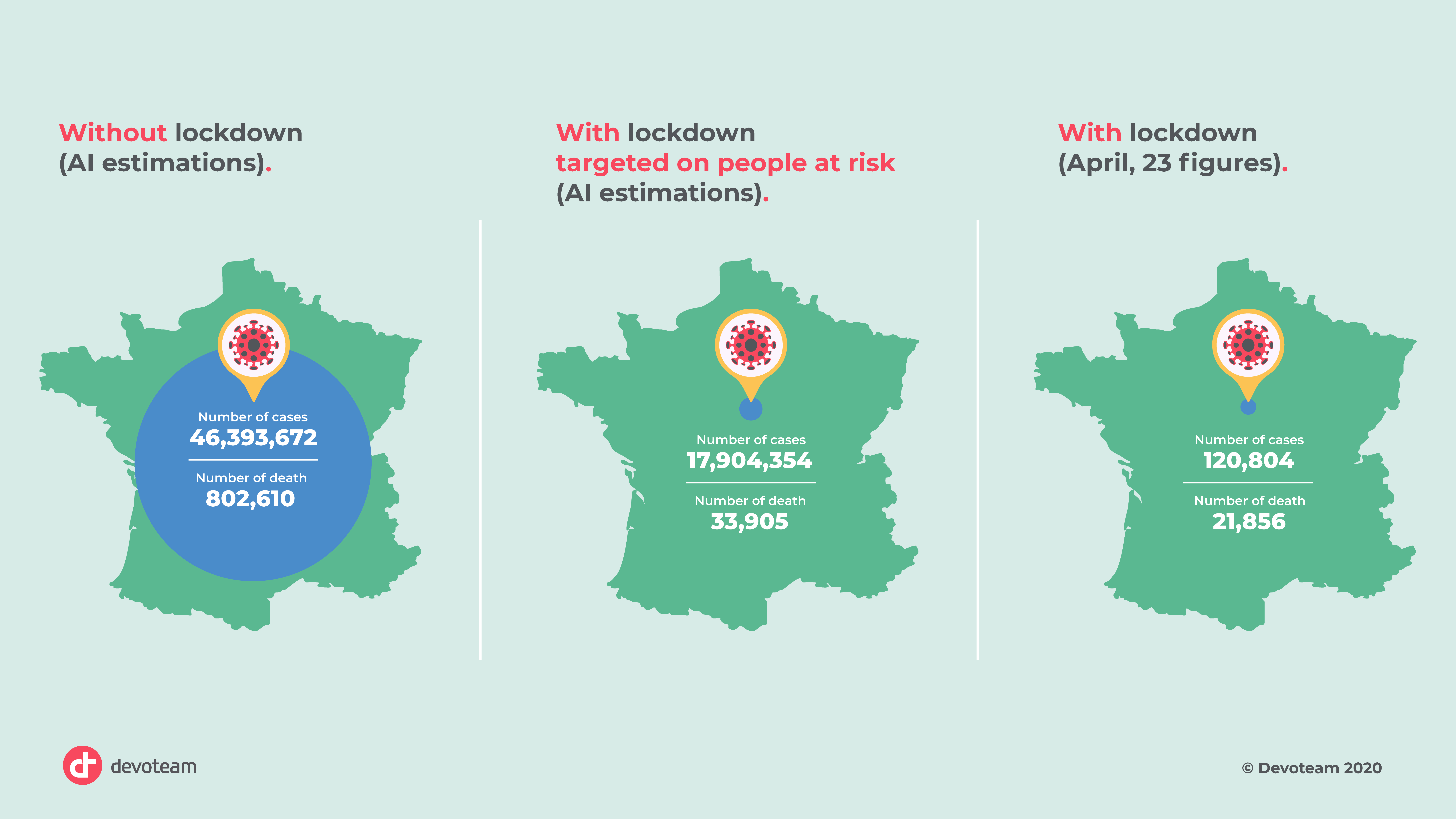Since March 17, France has applied drastic lockdown measures and severe travel restrictions to limit the spread of Covid-19.
What is the real impact of this widespread lockdown on the mortality rate and the number of cases of contamination? Could other lockdown methods, more targeted, have had a comparable effect? For Devoteam’s Data Scientists team, the answer is clear: their AI model estimates that more than 800,000 lives have been saved in France thanks to the total lockdown.

The model also reveals that lockdown applied only to people at risk (25 million people), and not to the entire population, gives an estimation close to 34,000 deaths.
Status of the situation without / with total or targeted lockdown according to Devoteam’s IA model
Situation as per April, 23 2020:

Basing lockdown measures on artificial intelligence models would allow us to adjust and balance them as accurately as possible according to the context. These data could be useful to define, for example, a progressive lockout plan, or be a decision-making tool in the more dramatic case of a second wave.
Stanislas de Bentzmann, CEO of Devoteam
Méthodology & Data sources
In this study, Devoteam’s AI team used data officially communicated by the French government, hospitals and “EHPAD” (houses for elderly or disabled people), open data (notably INSEE)[1] and data from the health insurance fund. The analysis was performed on the basis of several statistical tests on these data and used Machine Learning approaches to predict certain situations.
The approach used to estimate the current number of cases is based on the SEMMA methodology (sample, explore, modify, model, assess). The data scientists took into consideration the number of contaminations estimated per day since the beginning of the epidemic (source: Institut Pasteur) and the variance of the mortality rate announced by the different scientific communities around the world, including the Institut Pasteur (the mortality rate varies from 1 to 2% depending on the studies).
Devoteam’s data scientists used Machine Learning algorithms such as linear regression combined with internally developed approaches such as UCB (upper confidence bound) to find the estimated number of contaminations per region and ultimately deduce the total number of contaminations in France.
The approach is therefore different from the classical parametric statistical approach. The machine learning model used for predictions by Devoteam is an adaptive model, i.e. it adapts its features according to the different age groups. Consequently, the model is intelligent in adapting the mortality rate as a function of the population and the features by region.
The AI model defined by Devoteam has been trained on data from INSEE[1] [5], Statista[3] [4], planetoscope[2] and from a study by the Wuhan laboratory [6]. It embeds hybrid predictive models composed of classical decision tree and regression models combined with conditional symbolic AI under constraints. For the datasets used for training, data augmentation techniques have been applied on some data to have enough data for training.
Situation without lockdown
With this AI approach, the number of contaminated persons in the “without lockdown” case is estimated to be 46,393,672, a factor of 412 over the reported cases.
Taking into account those at risk, the mortality rate increases by 4.7% according to the predictions of our model, resulting in 802,610 deaths.
Situation with lockdown targeted on people at risk
The number of people at risk is currently around 25 million, i.e. more than a third of the French population (number based on health insurance data, 2017) and includes people with:
- Cardiovascular disease (complicated high blood pressure, stroke, coronary artery disease, history of heart surgery, stage NYHA III or IV heart failure)
- Diabetes (insulin-dependent diabetics who are unbalanced or have complications secondary to their condition)
- Chronic respiratory diseases (asthma, cystic fibrosis…)
- Chronic kidney failure
- Cancers (people under treatment)
- Stage B cirrhosis at least.
- Uncontrolled HIV infection
- Morbid obesity (BMI upper than 40kg/m²)
With the lockdown of at-risk people only, and their isolation during the epidemic period, the prohibition of visits in EHPAD, and the isolation of contaminated persons, the AI (identical to that used to estimate the number of contaminations without lockdown, therefore with the same algorithmic approach) calculates that the number of contaminated persons falls considerably compared to the situation without lockdown, to 17,904,354 cases.
In this case, the estimated mortality rate is 0.12%, resulting in 33,905 deaths.
In the case of such targeted containment with isolation of persons at risk from the start of the epidemic, out of the 17,904,354 contaminated cases, 1,834 persons would have been in a resuscitation situation, compared with 160,522 without containment and 5,053 at present. This figure would be lower than at present, despite a less extensive lockdown, because the lockdown would have been stricter on those at risk and would have been carried out as soon as the first cases were identified.
The last lesson of this Devoteam study, this time concerning herd immunity: in the case of a targeted population lockdown, herd immunity could have been achieved 3 months after the start of the targeted lockdown. At present, with the chosen strategy, the number of cases is too low to be able to envisage such immunity, nor to calculate it reliably.


Bibliography
[1] Number of employees in France https://www.insee.fr/fr/statistiques/4466574
[2] Number of people taking public transport per day (every second, 77 people take urban public transport in France) https://www.planetoscope.com/Mobilite/1334-nombre-de-trajets-en-transports-en-commun-en-france.html
[3]Number of people in shopping centres and markets per day https://fr.statista.com/statistiques/529501/centres-commerciaux-francais-nombre-visiteurs-annuel
[4] Number of people in the ER per day nhttps://fr.statista.com/themes/3462/les-urgences-medicales-en-france/
[5]The pollution level https://www.insee.fr/fr/statistiques/4160040
[6]Clinical Characteristics of 138 Hospitalized Patients With 2019 Novel Coronavirus–Infected Pneumonia in Wuhan, China
- Virus penetration rate
- Lifetime of the virus on obstacles
- The speed of transmission of the virus
